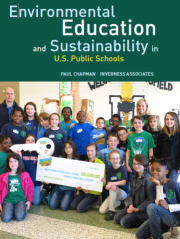A Map of Green Schools
In 2015 Inverness Associates completed an extensive effort to map the state of green schools nationally, and the results show ways in which private independent schools are playing leadership roles in the effort to create more environmentally sustainable schools. Over 25,000 school principals were surveyed, or approximately a fifth of the nation’s total, and the response rates from three parallel surveys allow for statistically meaningful generalizations about the strengths, weakness, challenges and opportunities our schools face.
A Note on Methods
The surveys were designed to assess sustainable schools as defined in Greening America’s Schools and Greening 2.0 (NAIS 2012, 2013), which their “five foundations”: in addition to being well organized, they use resources efficiently, focus on healthy operations, offer an ecological curriculum, provide nutritional food, and develop environmental stewards. An initial survey in 2013 of 1879 independent school principals, supported by NAIS and 14 state and regional associations, received a 36% response rate from school heads in 46 states and DC. In 2014 the survey was expanded to 7703 public schools in California, followed by a survey of 17,500 public schools in 12 representative states--HI, OR, WA, CO, KA, WI, MO, KY, FL, VA, MD, MA. While the response rates were lower (7%, 6%) in the public school surveys, they still allow for generalizations that are valid and reliable. It should be noted that generalizations are based on the perceptions of the school principals.
Key Findings
Based on comparative analysis, public and private school responses showed many similarities; for example, both public and private schools appear to be more focused on areas like energy efficiency and waste management/recycling than they are on incorporating environmental education in the curriculum. Significantly, however, independent schools appear to be more advanced in incorporating environmental education and sustainability in almost all categories measured. Among the factors contributing to independent school leadership are: strong commitment from school heads faculty and students; a governance model that allows for strategic changes in direction; school mission or green mission statements that include sustainability; adequate resources directed to green initiatives; a culture of innovation; and a sense of civic purpose. Public schools are challenged by limited resources, state mandated high stakes testing, large-scale bureaucracy, and political sensitivity. Independent schools face their own challenges, however, and often do not work in concert to achieve advantages of scale; some public school districts in fact, from Virginia Beach to Boulder to San Francisco, are achieving profound changes, especially in building green schools, healthy operations, renewable energy, when the district itself has made sustainability a high priority.
Detailed Findings
Here are some specific findings the surveys revealed:
- Interest in environmental sustainability higher in independent schools than public schools (42% vs. 29%, to a very great extent/great extent).
- Independent schools have a greater presence of green teams and green policies (53.7%, 48% vs. 51%, 37%) but fewer have a sustainability coordinator (27% vs. 39%).
- Two thirds (64%) of public schools spend less than $1000 a year on green activities like assembly speakers, field trips and professional development, while a third of independent schools (32%) report spending $10,000 or more.
- Environmental concern and engaged faculty and students account for independent school success (80%, 76%), while in public schools the principal’s role is relatively more important (60% vs. 55%).
- Waste reduction, recycling and composting are well developed in many independent and public schools (93% vs. 81%), while independent schools a leading the way in LEED buildings and with renewable energy (26%, 31% vs. 11%, 15%).
- The school garden movement and nutritious, local, organic food have caught on in independent schools and to a slightly lesser degree in public schools (83%, 44% vs. 57%, 19%).
- The integration of environmental education across the curriculum is just beginning; strikingly, 10% or fewer of independent and private schools define environmental literacy, require environmental education of any kind, or and assess its impact (8%, 7%, 10%, vs. 7%, 5%, 9%).
- An area where independent schools are especially strong is in integrating environmental education in the wider school program, through outdoor learning experiences (79% vs. 50%), service learning projects (73% vs. 41%), and using the campus as a learning laboratory (70% vs. 38%).
- Public and private school principals alike report key challenges in time, lack of funding, and inadequately trained personnel (70%, 64%, 35% vs. 68%, 73%, 39%); state mandates and teacher workload are challenges especially cited by public schools (54%, 73%).
Applying the Research
Here are specific steps all schools can take to strengthen their engagement with environmental education and sustainability:
- Provide leadership and made sustainability a top priority
- Benchmark your school’s performance
- Promote your successes on your website, and publicly
- Measure your footprint to manage efficiently
- Quantify and publicize your annual savings
- Adopt green operational policies
- Define environmental literacy
- Incorporate EE in the curriculum
- Assess student accomplishment
- Participate in the Green Ribbon Schools program
- Become a member of the Green Schools Alliance
- Join the National Green Schools National Network annual conference
And remember, green schools offer a “triple bottom line”: they save money, improve health, and boost achievement. Copies of the survey reports referenced in this article can be downloaded on the Inverness Associates website (invernessassociates.org).







